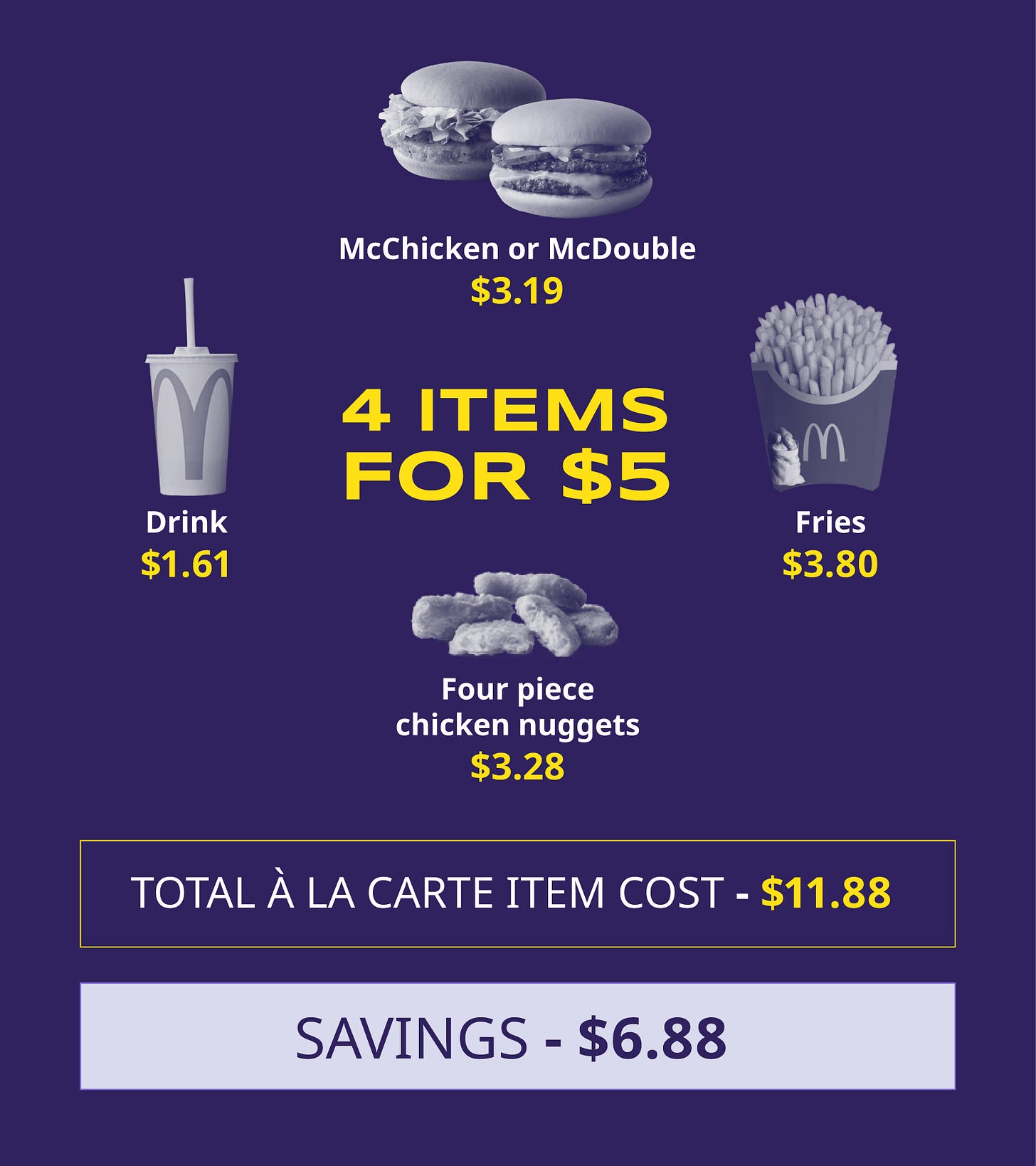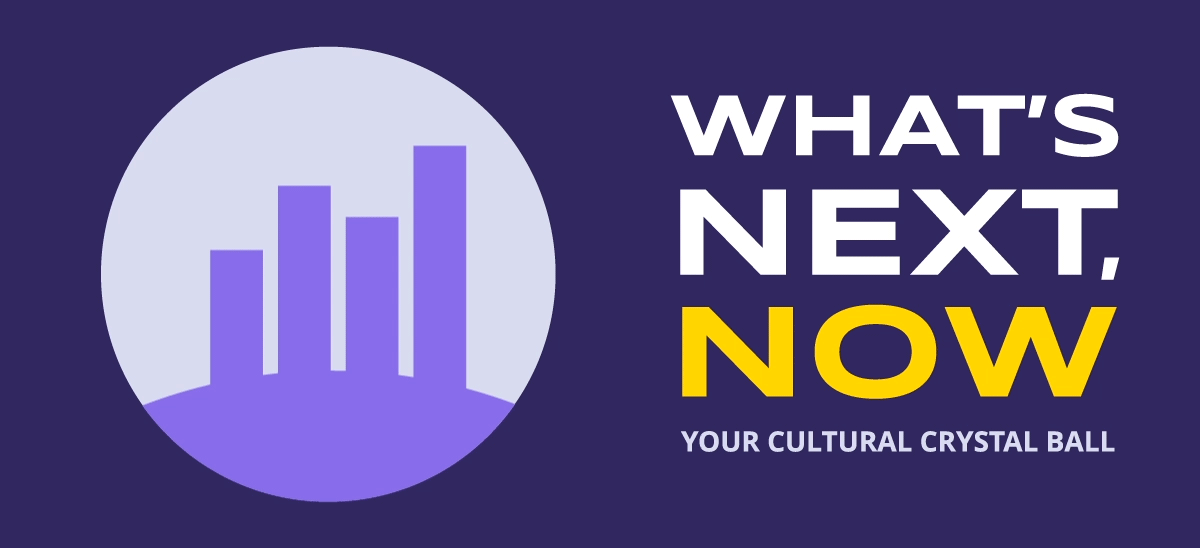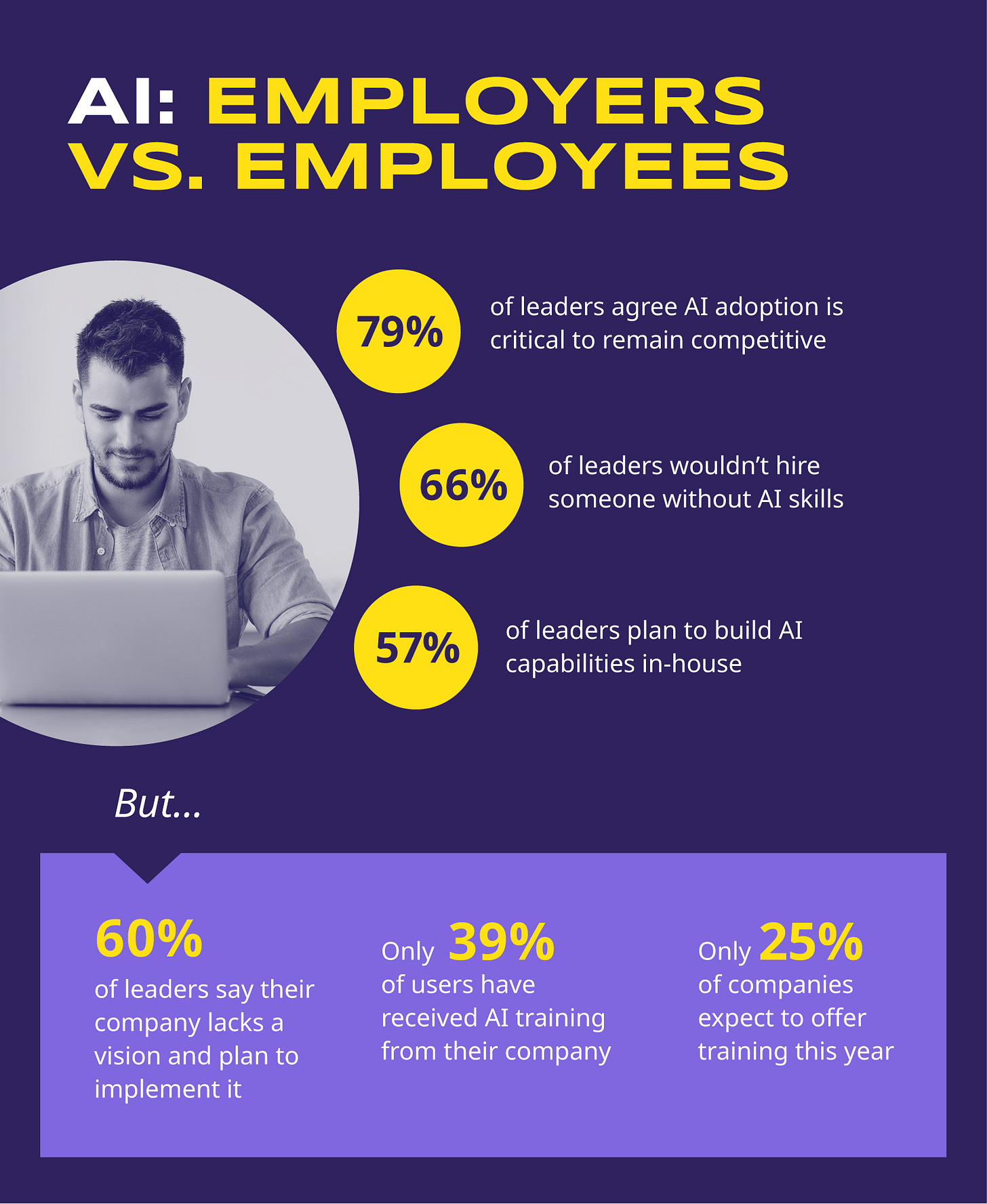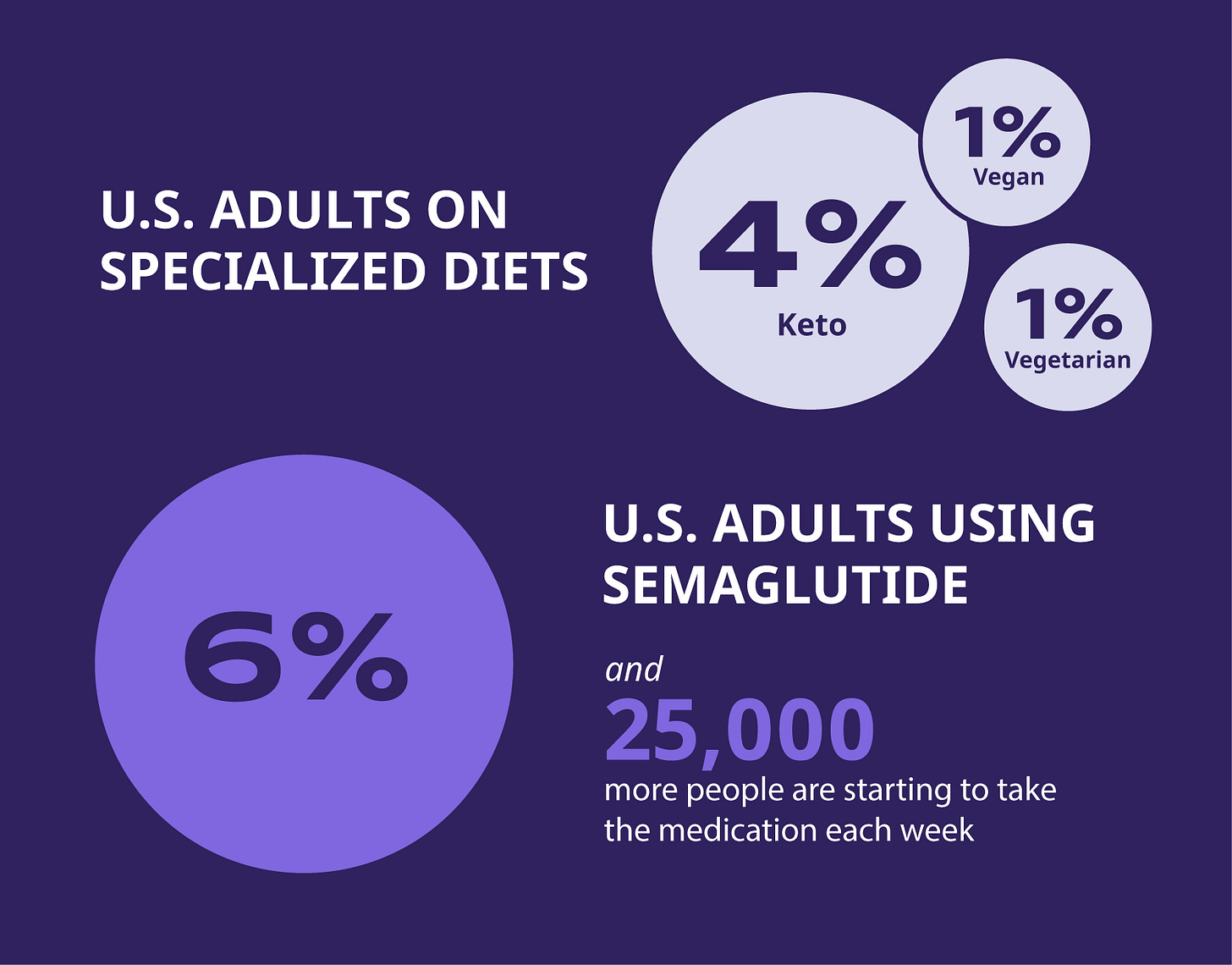What's Next, Now: May 2024
This month, our crystal ball predicts an employee/employer clash over AI, newsletters as the new social media, a turning point for gyms, and more.
A new study from Microsoft and LinkedIn revealed 3 in 4 knowledge workers (people whose jobs involve handling information, rather than manual labor) are now using AI at work — so we think it’s safe to say the AI revolution is here in the workplace. And it’s not just being driven by tech workers. In fact, McKinsey found that when looking at heavy users of generative AI, just 12% are in traditional tech roles. Instead, 88% of AI talent is found in non-technical jobs, with workers using generative AI for help with rote tasks.
Though AI is being put to use across job roles, the way employees and employers are approaching it isn’t always aligned.
Leadership wants workers to use AI, with 79% of leaders agreeing AI adoption is critical to remain competitive. And leadership wants their employees to have AI skills: 60% of executives wouldn’t hire someone without AI experience, and 57% plan to build their AI capabilities in house. But despite the pressure executives are putting on workers to use generative AI, employees feel they are not getting the support they need to succeed.
Only 39% of AI users say they have received AI training from their company, and just a quarter of organizations plan to offer AI guidance this year. Leadership has also not provided employees with a plan — the majority of leaders admitted they had no vision for how AI would be implemented at their company. This lack of direction is forcing employees to go about it their own way. Almost 80% of AI users are bringing their own AI tools to work, meaning companies are missing out on the benefits of strategic AI implementation at scale, not to mention the potential cybersecurity risks of AI misuse.
As AI tools become more powerful and their use more prevalent, any company without an AI strategy will only get left behind. But it’s risky (and ineffective) to put all the responsibility in the hands of employees. Heavy AI users know the value of their talents and aren’t afraid to take them elsewhere if they aren’t getting the proper support from their employers — McKinsey found over half of regular AI users plan to leave their jobs in the next three to six months. If these users move to greener pastures where they’re properly backed by their employers, it could result in a consolidation of AI talent. Some companies may miss out on the benefits of AI because they missed a crucial window of opportunity to provide resources and support for their workforce.
With a social media landscape constantly in flux, newsletters are stepping up as a new frontier. Newcomer beehiiv received $32M in a recent funding round, mirroring the business model of Substack — both of which are leading this revolution by transforming traditional newsletters into dynamic spaces for personal expression and community engagement.
While newsletters might sound like an offbeat replacement for social media platforms, they are surprisingly intimate, direct, and personal — helping them resonate with audiences tired of the noise of social media. These communities are even evolving beyond the internet. Early this month, the writers behind “Hate Reads,” a popular newsletter for airing grievances and pet peeves, brought their content IRL.
As the social media landscape continues to fragment, platforms are eagerly trying to appease creators. Most recently, Instagram made updates to its algorithm to prioritize original content and increase distribution for smaller accounts, but they might be too late to the game.
Substack is now also making its appeal to creators. Substack writers already take advantage of the direct monetization model of Substack, where they can make money directly through subscriptions without worrying about ad revenues or changing algorithms. Now, Substack wants to make the same offer for video-focused creators. In a new program, Substack will work with ten video-native influencers to help build their presence on Substack.
Newsletters are becoming more than just plain-text email updates — they’re evolving into interactive, multimedia experiences that might just be the next big thing in social media. In today’s chaotic social media moment, newsletters provide a calmer, more curated experience. As the social media landscape continues to evolve, newsletters are taking advantage of the opportunity to carve out their spot.
Public opinion on the power and potential of AI has run the gamut over the past year and half, from optimism and hype to confusion and fear. Now, consumers are beginning to differentiate what they view as acceptable AI use from practices that are bound to draw backlash.
The AI use case guaranteed to rile up AI skeptics is when the tech directly replaces a human — not just in the workforce, but also in the form of personal connections. Recent headlines about AI personalities taking on the role of a friend or companion have raised alarms about the erosion of genuine human connection. Bumble founder Whitney Wolfe Herd even suggested AI could go on hundreds of dates for you. And while some are finding comfort in using AI to replicate deceased friends and relatives or to discuss mental health issues, these applications have sparked ethical debates about the boundaries of the tech.
It’s not just 1:1 replacement that crosses the line. In areas where an end product seems inseparable from human creativity, such as in art, music, and writing, consumers still feel uncomfortable letting AI take over. Apple’s now-infamous recent iPad commercial wasn’t actually about AI, but the massive backlash to the ad spot illustrates how strongly consumers feel about a tech takeover (so strongly that Apple actually apologized for the commercial, something they’ve never done before).
When it comes to more everyday creative use, brands adopting AI-generated copy aren’t faring much better — according to a recent survey, 26% of consumers feel brands are impersonal if they use copy that does not seem human-written, and 20% feel these brands are lazy.
The AI revolution is being simultaneously shaped by business enthusiasm and consumer trepidation. While it’s no question AI is well on its way to helping us be more productive and efficient, some areas where companies see potential may not be fit for an AI takeover. So how can brands take advantage of the many promises of AI, without risking the wrath of their audience?
Number one: Read the room. Be mindful of tone and direction when implementing AI, and don’t go headfirst without considering the implications. And if you are going to be using AI for something that could draw backlash, be prepared to back it up. Clear communication about where, when, and how AI is being used will stem the tides of social media callouts.
Have you been foregoing your frappuccino? You’re not alone: consumer spending at establishments like Starbucks and McDonald’s has been slowing. All jokes about pricey coffees aside, these shifts in spending behavior may indicate an important economic pattern — consumers are no longer buying their little treats.
Starbucks is so ubiquitous — and its customers so reliable — that spending at the coffee chain is seen as a key indicator of consumer spending. During the return-to-office boom, traffic to the Starbucks was used as a metric to determine how many workers were back to in-person work environments. Now, some economists view Starbucks spending as an effective representation of consumer spending outlook. This recent slump in sales has experts wondering whether larger economic forces are at play.
Establishments that offer daily indulgences are especially struggling, another sign that middle-class consumers are starting to behave more like lower-income earners.
As consumers seek out better value for their already-stretched dollars, Walmart saw a 3.8% rise in same-store sales. Other businesses are racing to meet customers where they are: Target announced it has reduced prices on 5,000 items. McDonald’s is introducing a value meal for a limited time, and Starbucks is offering a variety of enticing deals this month.

We recently discussed the prevalence of shrinkflation and how companies had a unique opportunity to acknowledge the struggles of consumers. As buyers have decidedly shifted their purchasing habits, the pressure’s on for businesses to respond. It seems, at least for the moment, that companies may be turning a corner and aiming to offer more product for lower costs.
Keep an eye on how these companies adjust their strategies long-term. A brief attempt to lure back customers may not be enough to address the significant economic pressure at play in shifting purchase habits. If brands don’t see success with lower prices, they may try expanding opportunities for spaving — the practice of spending money to save money. Businesses may continue to leverage interest in paid rewards programs to draw in new customers with better value while retaining their existing base with discounts and other incentives.
2024 was not off to a good start for gyms. Based on mobile phone location data, foot traffic to 10 major gyms in January was unchanged from the year prior. That may not seem too bad, but new-year sign ups usually spark a more than 40% rise in gym visits. With that in mind, gyms were forced to readjust and roll out new strategies to make up for lost membership and revenue.
In a surprising turn, Planet Fitness announced it will raise base pricing for new members from $10 to $15 — their first price increase since 1998. In 2022, the company proudly proclaimed that their $10 pricing was “almost sacrosanct” and “a key part of the company’s brand positioning” — but that didn’t seem to hold up when profit was at stake.
At the far other end of the gym spectrum, the high-end fitness club Equinox is doing its best to rebound. Equinox raised $1.8 billion from private capital investors to refinance $1.2 billion in debt, much of which was accrued during the pandemic gym drought. The company’s revenue increased 27% in 2024, and the group is building 25 new clubs to expand its existing footprint by roughly 20%.
Part of Equinox’s success could be attributed to its dedication to diversification — and the rise of weight-loss medications like Ozempic. The company recently announced a $3,000-a-month, longevity-focused wellness program called Optimize by Equinox. While they’re not offering access to the drugs themselves (unlike WeightWatchers), Equinox established a Health Advisory Board of fitness professionals and doctors to create custom-tailored programs for customers using these drugs.
While a declining interest in gyms could indicate an increase in body neutrality, consumers are still trying to lose weight. According to a 2023 study by the International Food Information Council, the greatest motivators for adopting specialized diets are losing weight (43%), and physical appearance (39%), both increased from the year prior.
But interest in weight loss is only one piece of the puzzle as the pursuit of “wellness” continues to gain steam. Gymgoers, particularly Gen Z, are increasingly seeking holistic experiences that benefit not just their physical appearance and fitness, but also their mental health and connection with community.
In an uncertain economic climate, customers bristle at the idea of spending more for the same offerings. But by diversifying and offering value in new ways, companies can fill new needs — and potentially charge accordingly. B2B companies that offer services like personalization may be able to help B2C businesses improve their ability to retain and attract customers.
A TikTok ban could affect more than just everyone’s favorite short-form video platform. The language in the bill is broad enough to restrict apps owned, operated, or controlled by any company with the designation of a “foreign adversary” — including CapCut, the go-to editing app for creators across platforms.
The economic outlook for young Americans is bleak — Americans have spent the savings they built up during the pandemic, and Gen Z continues to sink deeper into debt.
Cowboy culture is taking over.
Want to hear more? Explore the Tier One blog, TOP TALK, for the latest digital marketing trends, tips, and insights.
Copyright © 2024 Tier One Partners is a women-owned full-service PR, content, and digital marketing agency. We work with innovators in B2B and B2C technology, digital healthcare, financial services, energy tech, and manufacturing to develop award-winning creative, data-driven strategies that propel them to industry leader status. From day one, we’re committed to earning our clients’ trust, sharing their vision, and embedding their purpose into everything we do. To learn more, visit wearetierone.com.

















